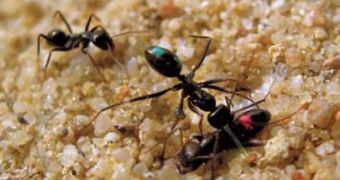It would appear that ants, besides being some of the most organized and widespread creatures on the face of the planet, are also loyal comrades. In experimental setups, they were found to return after comrades that had been ensnared using an unconventional trap. Those who returned for the prisoner made all possible efforts to release the others from their predicament. Details of the new study appear in the latest issue of the open-access scientific journal PLoS ONE.
The new find sheds a different light on the insects, for one simple reason. Instances in nature when an animal from a species jeopardizes its own safety in order to rescue others (altruistic behavior) are very rare. However, similar types of acts such as grooming and foster parenting still exist. But the ants are among a very select group of animals, including humans, that rescues others simply because it is a part of the same species, LiveScience reports. The only other two groups of animals that have been reported to do that are dolphins and capuchin monkeys.
Scientists from France and the United States have recently conducted a series of experiments on the ant Cataglyphis cursor, and have determined that this type of altruistic behavior is not only present, but also highly complex. University of Paris North expert Elise Nowbahari and Mount Holyoke College scientist Karen L. Hollis created a setup in the lab that was very similar to situations ants commonly had to confront, such as navigating terrain where sand and pieces of debris fell on them continuously.
On numerous instances, these loose pieces of ground trap ants, and the study has found that others quickly jump to their rescue. But the scientists added a twist. The ant that was placed in the sand had been firmly tied in place with a nylon string. The insect's nest-mates dug relentlessly around the trapped creature, and then prodded by its limbs until they found the string. They then began to chew on it, in an effort to set their comrade loose. This type of behavior was not recorded for ensnared ants from other nests, or for other insects altogether.
This fact hints at an evolutionary adaptation that the ants had to go through in order to survive in dangerous environments. This type of behavior is not usually favored by evolution, because the individual doing the rescue risks losing its own life for that of another. In the case of the Cataglyphis cursor ant, the individuals saving their brethren had no other reward for their action than kin selection.

 14 DAY TRIAL //
14 DAY TRIAL //